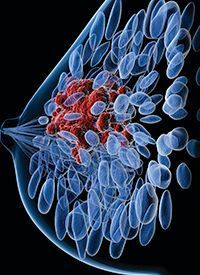Article
Retesting for HER2 Upon Breast Cancer Relapse May Provide New Therapeutic Opportunities
Author(s):
Approximately 30% of breast cancer tumors can covert from, or to, HER2-low status, underscoring the need to retest for HER2 expression upon relapse.

Approximately 30% of breast cancer tumors can covert from, or to, HER2-low status, underscoring the need to retest for HER2 expression upon relapse, according to results from a study presented during the ESMO Breast Cancer Virtual Congress 2021.1,2
Results indicated that 14% of triple-negative breast cancers with HER2-negative expression in the primary tumor were found to convert to HER2-low expression upon recurrence.
Moreover, 29% of recurrent breast cancer biopsies demonstrated conversion either from, or to, HER2-low expression. HER2-low expression was observed in 34% of primary tumors and 38% of relapse tumors. Notably, 15% of HER2-negative tumors were found to have switched to HER2-low tumors, while 14% of HER2-low tumors switched to HER2-negative tumors.
“The results provide a whole new insight on how HER2-low tumors might evolve as a subgroup, possibly challenging the current dichotomy between HER2-positive and HER2-negative breast cancer,” Federica Miglietta, MD, of the Department of Surgery, Oncology, and Gastroenterology, University of Padova, Italy, stated in a press release. “Our findings stress the importance of retesting HER2 expression on tumor relapse since it might provide the option of new therapeutic opportunities, currently in a trial, and hopefully in the near future, in the clinic.”
Approximately half of breast cancers that are classified as HER2 negative have a low HER2 expression and can be targeted by novel antibody-drug conjugates. However, historically, there have been no data on the evolution of HER2-low status from primary tumor to relapse.
The study enrolled 575 patients with matched primary and relapse breast cancer samples from 2 institutions: IOV-IRCCS Padova and Treviso Hospital. HER2 status was assessed according to ASCO/College of American Pathologists recommendations that were in place at the time of diagnosis.
Breast cancer cases that were diagnosed between 2007 and 2013 underwent review by immunohistochemistry (IHC) to comply with the cutoff of greater than 10% cells staining for HER2 positivity. A total 100 random samples were reviewed by a blinded pathologist and agreement with the original report was 80%. HER2-negative cases were subclassified as either HER2-low (IHC 1+ or IHC 2+ and ISH not amplified) or HER2-0 (IHC 0).
Fifty-nine percent of patients had a primary tumor phenotype that was luminal-like (hormone receptor [HR]-positive/HER2-negative), 25% were HER2-positive, and 16% were triple negative.
Additional data indicated that HER2-low expression was more commonly observed in HR-positive/HER2-negative tumors vs triple-negative tumors. On primary tumor samples, 47% of HR-positive/HER2-negative tumors had HER2-low expression vs 36% of triple-negative tumors; these rates were 54% vs 36%, respectively, on relapse samples. The switch from HER2-negative status to HER2-low status in primary to recurrent tumors was 21% in luminal-like tumors and 14% in triple-negative tumors.
“These changes on HER2-low levels are substantial,” Aleix Prat, MD, PhD, head of Medical Oncology at the Hospital Clinic of Barcelona, Spain, said in the release. “There could be biological rationale for this, or a technical one, given that there is currently no standardization of how to determine levels of the HER2 biomarker in metastatic biopsies, which could be biopsied from skin, liver, or bone and give different results.”
Prat added that it is important to determine just how HER2 status correlates with response to treatments. “Is it the HER2 status in the primary tumor, or in the metastatic biopsy that is important” Prat questioned. “Maybe some patients have HER2-low expression in metastatic tumors and now respond when they didn’t previously, and this might change again over time and further relapses.”
Investigators concluded that HER2-low expression is very unstable during disease evolution and these data underscore the need to biopsy metastatic tumors.
References
- Miglietta F, Griguolo G, Bottosso M, et al. HER2-low breast cancer: evolution from primary breast cancer to relapse. Presented at: ESMO Breast Cancer Virtual Congress 2021; May 5-8, 2021; virtual. Abstract 4 MO_PR.
- The switch of breast tumours to HER2-low status in recurrence might provide greater therapeutic options. News release. ESMO. May 8, 2021. Accessed May 5, 2021.









